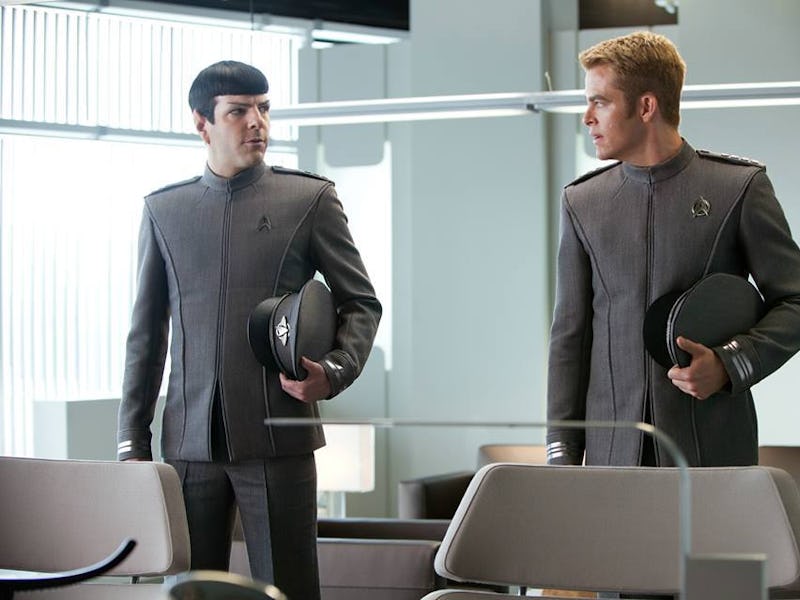Why the Interspecies Relationships in 'Star Trek' are Important
Reproductive isolation tells us that the chances of half-Klingon, half-human offspring aren't great, but 'Star Trek''s relationships are about more than a genetics lesson.

Relationships between humans and humanoid aliens is something of a staple on Star Trek. A part of the Trek canon from the outset, interspecies mating isn’t uncommon on the show and makes for some really interesting social commentary about prejudice and diversity.
Even so, interspecies relationships cannot lead to children, due to reproductive isolation, the mechanism that keeps genetically dissimilar species from reproducing.
The Star Trek universe’s internal logic explains that all humanoid life forms originated from a common ancestor. Thanks to a process called speciation, we get humans and Vulcans and Klingons and a whole slew of other humanoids in the galaxy. The big factor in speciation, though, is reproductive isolation, meaning that when speciation occurs (not overnight, mind you — it’s a damn slow process), members of these new species are no longer able to mate. Womp womp.
There’s some explanation for evolution in Star Trek — it’s a bit soft, but it’s there. It’s also worth noting, though, that Star Trek employs the future-set sci-fi quick fix of attributing supposedly impossible phenomena on major advancements in science, medicine, and technology. In this case, that quick fix is crazy advanced genetic engineering.
We know that some of the species that have relationships in Star Trek are very different, and what we know about genetics and reproductive isolation makes a pretty good case for ruling out viable offspring from these relationships.
Reproductive isolation works in a number of ways, but falls under two main categories: prezygotic and postzygotic. These are fancy ways of saying “before and after animals get jiggy with it.”
Pre-zygotic reproductive isolation refers to factors that might keep two species from mating. Things like different mating seasons or rituals, different habitats, and geographical locations, or a simple case of incompatible parts.
Postzygotic reproductive isolation refers to factors that keep two species from reproducing viable offspring, whether that means preventing an embryo from developing thanks to incompatible genetic information or by producing sterile offspring.
For the most part, when looking at interspecies mating in the Star Trek universe, we’re probably looking at cases of postzygotic reproductive isolation, meaning that although we’re largely looking at species which are fundamentally human or humanoid, genetic differences (like iron vs. copper-based blood or insurmountable physiological differences arising from species and planetary adaptations) would likely prevent viable offspring.
I know, I know: What about hybrids?
Hybrids do exist, though they’re not typically what you’d consider “viable offspring,” owing to the fact that they may be sterile (think mules). Moreover, hybrid species typically occur when reproducing species that are quite genetically similar (think dog breeds, and even then hybrids aren’t a one-and-done game) or when there’s some evolutionary impetus.
Considering that completely different genetic makeup, different blood, and very different physiology aren’t exactly “small” problems.
While it’s tough to believe that interspecies relationships would be capable of producing viable offspring given what we understand about reproductive isolation, Star Trek was never intended to be a genetics lesson. It’s always been about social commentary, and for that reason, its interspecies relationships make for some of the universe’s most compelling elements.
Relationships between very different alien races coming from very different backgrounds help to overcome stereotypes, prejudice, and barriers put in place by the galactic “society.” Star Trek has always been casually progressive when it comes to race and gender, and extending the forward-thinking principle of equality and respect for all to interspecies relationships seems the logical next step.
The existence of relationships like the one between B’Elanna Torres (half-human, half-Klingon) and Tom Paris (regular ol’ human) or between B’Elanna’s parents (human and Klingon) is a clear commentary on our fundamental similarities and the ways in which we’re better together.
Star Trek often illustrates the deep divides that exist between alien races like Klingons, Vulcans, and humans, but perhaps the interspecies relationships within the Star Trek universe are a testament to the power of love and the inherent value of overcoming our differences to work (and maybe sleep) together. Star Trek isn’t great for genetic lessons, but it’s always been a pretty good source of valuable life lessons.